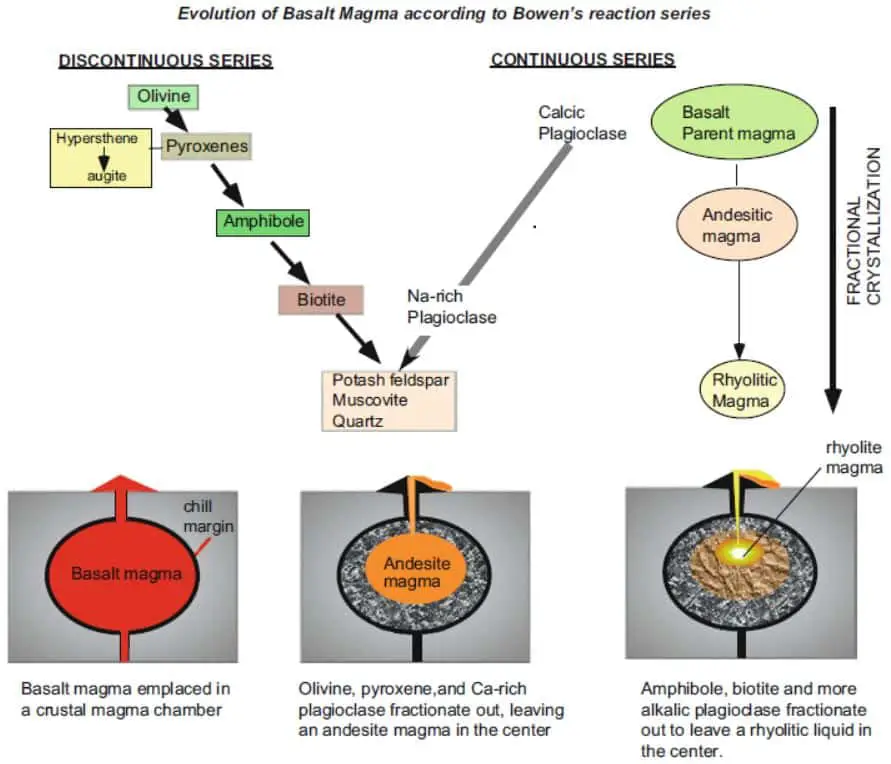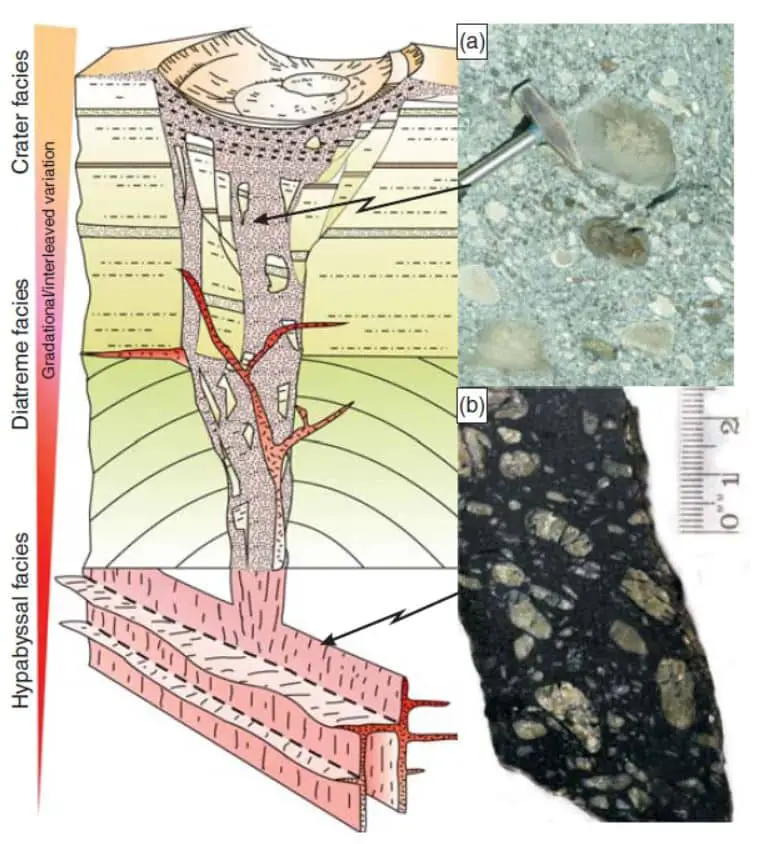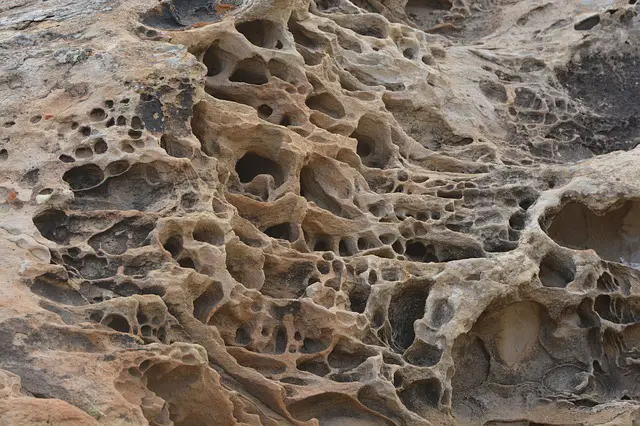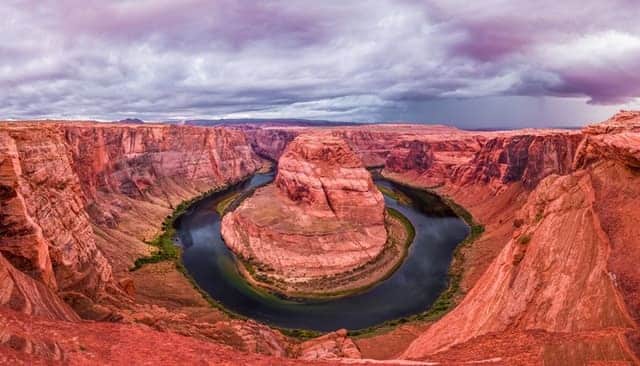The Earth’s structure is made up of the crust, mantle, outer core, and inner core. Magma makes up the majority of the planet’s mantle. The term Magma refers to the molten rock found in the Earth’s interior, below the surface. This molten rock, magma, can breach cracks or crustal fissures hence igniting a volcano. Upon solidification, lava or magma transforms into igneous rocks. Along with minerals, magma has trace quantities of dissolved gases including carbon dioxide (CO2), water vapor, and sulfur (S). Massive pressure and heat beneath the Earth’s crust keep magma in a fluid state.
The main difference between magma and lava is their location. Lava refers to molten rock ejected from the Earth’s interior during a volcanic eruption. Magma is molten rock that is still in the Earth’s interior. Many different types of magma can be found all over the world. Some of these include andesitic, basaltic, rhyolitic, and dacitic magma. They each form from different minerals that have melted. Basaltic magma forms from the minerals iron, magnesium, calcium, olivine, and pyroxene.
Initial Composition of Magma

The source rock type and partial melting determine the initial makeup of magma. Mafic/basaltic magmas are often produced when a mantle source (garnet peridotite) melts. More siliceous magmas are made when crustal heads melt.
Generally, lower degrees of partial melting create more siliceous magmas. Less siliceous compositions can be created as partial melting progresses. Thus, melting a mafic rock produces intermediate or felsic magma. Basaltic magma is produced when ultramafic rock (a peridotite source) melts.
Magmatic Differentiation
The magma’s chemical makeup may change due to processes that occur during transit to the point of deposition in the crust or to the surface. These processes include mixing, assimilation, and fractional crystallization and are known as magmatic differentiation.
Assimilation – On its ascent to the surface, magma can partially melt the adjacent rocks as it moves through cooler rock; this melt will then be incorporated into the magma. Introducing this melt will increase the silica content of the magma since minor quantities of partial melting produce the siliceous fluid composition.
Mixing – Two types of magma with dissimilar compositions could mix if they were to come into touch with each other. The combined magma mixture will fall somewhere between the two original compositions. The resultant rocks frequently contain remnants of the mixing process.
Crystal Fractionation – Magma may solidify to create a rock at various temperatures. Every mineral crystallizes at a different temperature; thus, if any of these minerals are taken out of the fluid, the fluid will alter in composition. Various compositions can be formed depending on the number of minerals lost in this way. This process is referred to as magmatic differentiation by crystal fractionation.
There are several methods for removing crystals. Crystals may sink if their density is greater than that of the magma. Mineral crystals will float if their density is lower than the fluid. They will remain behind if pressure is used to push the liquid out.
Types of magma based on composition
The rock that primarily melts (the source rock) and processes that take place through partial melting and transit affect magma’s chemical composition.
Basaltic magma

Magnesium, iron, and calcium are all plentiful in basaltic magma, while sodium and potassium are scarce. Basaltic magma’s temperature ranges between 1000 and 1200 oC (1832oF to 2192oF). The mentioned minerals (Fe, Ca, and Ma) are in a modest proportion in andesitic magma, with a temperature range of around 800oC to 1000oC (1472oF to 1832oF). Magnesium, iron, and calcium are in low amounts of rhyolitic magma, whereas sodium and potassium are abundant. Rhyolitic magma occurs in temperatures between 650 and 800 oC (1202oF to 1472oF). The number of minerals and the magma’s temperature both have an impact on its viscosity.
Rhyolitic Magma
Magnesium, iron, and calcium are limited in rhyolitic magma, whereas sodium and potassium are abundant. Rhyolitic magma forms in temperatures ranging between 1202oF to 1472oF. Silica makes up around 69 to 74% of low-silica rhyolite. High-silica rhyolite content ranges from 75 to 80% silica. Dense rhyolitic lava flows usually form thick, blocky lava flows or steep-sided lava domes. Rhyolite magmas often have large amounts of ash and pumice and violent eruptions.
A rhyolite is a volcanic rock or fine-grained extrusive igneous rock. It has a pale hue, typically light brown, pinkish, or light grey. When compared to water, rhyolitic magmas frequently have viscosities between one million and one hundred million times higher. (Remember that solids, although solid, have an extremely high viscosity that is billions of times greater than that of water).
Andesitic magma
Andesite magma erupts from stratovolcanoes, and thick lava flows, some of these lava flows are several kilometers long. Pyroclastic flows, surges, and enormous eruption columns can also be produced during intense explosive eruptions of andesite magma. Andesites erupt at temperatures ranging from 900 and 1100 ° C. Andesite magma strata’s density ranges from 2.64 to 2.84 g/cm3, which correlates to felsic and mafic rock makeup variations.
Felsic magma
A silicate mineral, rock, or magma abundant in lighter elements, including silicon, aluminum, oxygen, potassium, and sodium, is referred to as felsic. Felsic magma/lava’s viscidness is greater than that of mafic magma or lava. Felsic rocks often have light colors and specific gravities under 3.
Mafic magma
Mafic magma is characterized by a lower silica content than silicic magma and typically less viscous and gas-rich. Mafic magma tends to erupt as the lava flows effusively. This type of magma includes andesites (57–63% SiO2), basaltic andesites (53–57% SiO2), as well as basalts (47-53% SiO2). Mafic magma is more common in volcanic eruptions that aren’t explosive. Mafic magma’s temperature is about 1,200 °C (approximately 2,200 °F), is characterized by flowing lava, and contains around 45–65% silica (SiO2) in mass.
Granitic magma
Granitic and basaltic magmas are significantly dissimilar from one another. Granitic magma contains around 20% more silica, and the crystal structures of the minerals in granite (mica, amphibole) have a lot of water. The majority of granitic magmas are found only in continental crustal regions. Granitic magma comprises 10% water and 70% silica compared to basaltic magma’s 1% to 2% water and 50% silica.
The viscous magma is caused by more silica (stiff). Granitic magma, therefore, readily crystallizes in the crust, whereas basaltic magma can rise to the Earth’s surface. Granite magmas are substantially less dense, 2.4 Mg/m3, than high-grade metamorphic rock, which has a density of 2.8 Mg/m3. This provides them a ton of buoyancy, making the magma’s ascent inevitable once enough of it has collected.
Ultramafic magma
Silicon, magnesium, and carbon dioxide are the main constituents of ultramafic magma, produced by mantle rocks’ metamorphism and small amounts of the oceanic crust. Calcium, iron, and aluminum are present in much lesser quantities.
Yellowstone magma
Rhyolite and basalt are two forms of lava that erupt in Yellowstone. The most notable magmas in Yellowstone are rhyolite ones because they have a high explosive potential. In actuality, the creation of the modern Yellowstone caldera was caused by a significant eruption of rhyolite. The last lava flow in Yellowstone happened roughly 70,000 years ago. But even now, hikers may still see traces of previous eruptions throughout the park’s pathways in the shape of unique rock strata. Near the cliffs around the Upper Geyser Basin, close to Old Faithful, there is some indication of newer lava flows.
Primitive magma
Primitive magma: These unaltered magmas are produced by anataxis or the melting of mantle rocks whose composition has not changed since they originated.
Any chemically unaltered melt originating from any form of previous rocks is referred to as primary magma.
Kimberlite magma

Kimberlite magma is a type of magma that is found in the Earth’s mantle. Kimberlite magma is a type of ultramafic magma that is very high in magnesium and iron. It is named after Kimberley in South Africa, where the first kimberlite deposit was discovered in 1871. Kimberlite magma is very rare, and only a few hundred kimberlite deposits have been found worldwide. Kimberlite magma is important because it can be used to study the Earth’s mantle.
Alkaline magma
Alkaline magma is often characterized by high titanium oxide (TiO2) concentration, usually greater than 3% by weight. Additionally elevated are other incompatible elements, including phosphorus and light rare earth metals.
Mt St Helens magma type
The American state of Washington is home to Mount St. Helens, a volcano. The volcano is a portion of the Cascade Mountain range and is situated in the Pacific Ring of Fire’s Cascade Volcanic Arc, which is home to approximately 160 active volcanoes. The largest volcanic eruption in the continental United States in recorded history occurred on Mount St. Helens in 1980. The mountain’s north face collapsed prior to the volcanic eruption due to a series of steam explosions and earthquakes, and the ensuing landslide formed a sizable crater in the shape of a horseshoe on the mountain’s north side.
Volcanic Eruptions
Magmas that form deep inside the Earth typically start to rise since they are less dense than the nearby hard rock. The dissolved gasses may reach a depth or pressure as they ascend, where they can no longer be retained in the magma and start forming a distinct phase. A gas bubble that has formed will enlarge even more when the pressure decreases and more gas escapes from the fluid.
If the liquid component of the magma has a low viscosity, the gas can expand quite easily. When the magma reaches the Earth’s surface, the gas bubble will burst, the gas will swiftly expand to atmospheric pressure, and a non-explosive eruption will take place, often as a lava flow. If the liquid portion of the magma is extremely viscous, the gas won’t be able to expand rapidly, causing pressure to build up in the gas bubble (s). The gas bubbles in this magma will have a high internal pressure when it reaches the surface, which will cause them to explode violently once it meets air pressure. There will be a violent volcanic explosion as a result.
Effusive (Non-explosive) Eruptions
Non-explosive eruptions are encouraged by low gas concentration and low viscosity magmas (basaltic to andesitic magmas). Since dissolved gases are released when the viscosity is low, non-explosive eruptions frequently start with fire fountains. Lava refers to the molten rock (magma) that has reached the Earth’s surface. It responds to gravity by flowing downward, as lava is a liquid. Based on the viscosity, temperature, and gas concentration, various magma types react differently when lava flows.
Lava Flows
Pahoehoe Flows – Low-viscosity basaltic lava flows begin to cool when exposed to the chilly air. This creates a surface skin, which may bend and behave plastically despite still being very hot.
A’A’ Flows – Increased viscosity in basaltic and andesitic lavas initially forms a smooth surface skin, but this is swiftly destroyed by the lava’s internal movement and gas that continues to escape from it. This results in an A’A’ flow’s distinctive rough, clinkery surface.
Pillow Lavas – When lava erupts on the bottom of a sea or other body of water, the skin on the surface quickly develops and, like pahoehoe toes, is inflated by molten lava. Pillow lavas are inflated magma balloons that deflate and pile up like pillows. Due to their structure, glassy borders, and cooling-induced radial fractures, old pillow lavas are easily identifiable.
Siliceous Lava Flows – Since they can’t flow freely, andesitic and rhyolitic lava flows with high viscosities generate thick, stubby flows that don’t flow very far from the vent.
Lava Domes or Volcanic Domes – are produced by the ejection of andesitic and rhyolitic lava, both very viscous and gas-poor. Lava doesn’t flow away from the vent because of the high viscosity; instead, it builds up above the vent.
Explosive Eruptions
High viscosity and gas concentration facilitate explosive eruptions (andesitic to rhyolitic magmas). The magma is broken up into liquid clots by explosive bubble bursts, and these clots cool as they fall through the atmosphere. These rock pieces turn into pyroclasts, heated fragments, tephra, volcanic ash, sand- or smaller-sized bits.
References
Basaltic magma | geology | britannica. (n.d.). Retrieved January 10, 2023, from https://www.britannica.com/science/basaltic-magma
Berlo, K., Tuffen, H., Smith, V. C., Castro, J. M., Pyle, D. M., Mather, T. A., & Geraki, K. (2013). Element variations in rhyolitic magma resulting from gas transport. Geochimica et Cosmochimica Acta, 121, 436-451.
Heap, M. J., Tuffen, H., Wadsworth, F. B., Reuschlé, T., Castro, J. M., & Schipper, C. I. (2019). The permeability evolution of tuffisites and implications for outgassing through dense rhyolitic magma. Journal of Geophysical Research: Solid Earth, 124(8), 8281-8299.
Lustrino, M. (2005). How the delamination and detachment of lower crust can influence basaltic magmatism. Earth-Science Reviews, 72(1-2), 21-38.
Magma | national geographic society. (n.d.). Retrieved January 10, 2023, from https://education.nationalgeographic.org/resource/magma
Magma(Characteristics, types, sources, and evolution). (n.d.). Retrieved January 10, 2023, from https://www.geologyin.com/2015/08/magma-characteristics-types-sources-and.html
Métrich, N., & Wallace, P. J. (2008). Volatile abundances in basaltic magmas and their degassing paths tracked by melt inclusions. Reviews in mineralogy and geochemistry, 69(1), 363-402.
Pyle, D. M. (2015). Sizes of volcanic eruptions. In The encyclopedia of volcanoes (pp. 257-264). Academic Press.
Robock, A. (2000). Volcanic eruptions and climate. Reviews of geophysics, 38(2), 191-219.
Volcanic eruption—An overview | ScienceDirect topics. (n.d.). Retrieved January 10, 2023, from https://www.sciencedirect.com/topics/earth-and-planetary-sciences/volcanic-eruption
Volcanoes, magma, and volcanic eruptions. (n.d.). Retrieved January 10, 2023, from http://www2.tulane.edu/~sanelson/Natural_Disasters/volcan&magma.htm
Yoder Jr, H. S. (1973). Contemporaneous basaltic and rhyolitic magmas. American Mineralogist: Journal of Earth and Planetary Materials, 58(3-4_Part_1), 153-171.




[…] of the Earth’s lithospheric plates. When these plates diverge or move apart, molten rock or magma from the mantle rises and solidifies, creating a new oceanic crust. Interestingly, mid-ocean […]